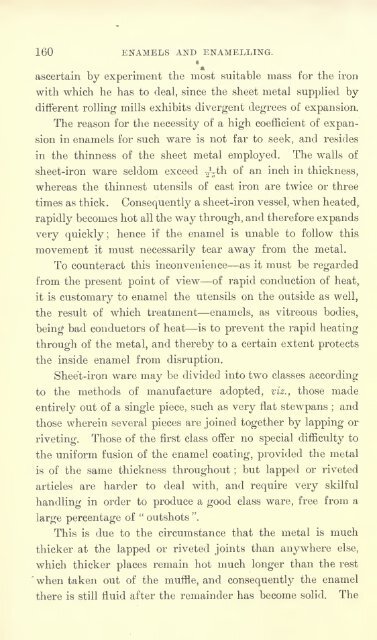Enamels and enamelling; an introduction to the preparation and ...
Enamels and enamelling; an introduction to the preparation and ...
Enamels and enamelling; an introduction to the preparation and ...
Create successful ePaper yourself
Turn your PDF publications into a flip-book with our unique Google optimized e-Paper software.
160 ENAMELS AND ENAMELLING.<br />
ascertain by experiment <strong>the</strong> most suitable mass for <strong>the</strong> iron<br />
with which he has <strong>to</strong> deal, since <strong>the</strong> sheet metal supplied by<br />
different rolling mills exhibits divergent degrees of exp<strong>an</strong>sion.<br />
The reason for <strong>the</strong> necessity of a high coefficient of exp<strong>an</strong>-<br />
sion in enamels for such ware is not far <strong>to</strong> seek, <strong><strong>an</strong>d</strong> resides<br />
in <strong>the</strong> thinness of <strong>the</strong> sheet metal employed. The walls of<br />
sheet-iron ware seldom exceed ^th of <strong>an</strong> inch in thickness,<br />
whereas <strong>the</strong> thinnest utensils of cast iron are twice or three<br />
times as thick. Consequently a sheet-iron vessel, when heated,<br />
rapidly becomes hot all <strong>the</strong> way through, <strong><strong>an</strong>d</strong> <strong>the</strong>refore exp<strong><strong>an</strong>d</strong>s<br />
hence if <strong>the</strong> enamel is unable <strong>to</strong> follow this<br />
very quickly;<br />
movement it must necessarily tear away from <strong>the</strong> metal.<br />
To counteract this inconvenience as it must be regarded<br />
from <strong>the</strong> present point of view of rapid conduction of heat,<br />
it is cus<strong>to</strong>mary <strong>to</strong> enamel <strong>the</strong> utensils on <strong>the</strong> outside as well,<br />
<strong>the</strong> result of which treatment enamels, as vitreous bodies,<br />
being bad conduc<strong>to</strong>rs of heat is <strong>to</strong> prevent <strong>the</strong> rapid heating<br />
through of <strong>the</strong> metal, <strong><strong>an</strong>d</strong> <strong>the</strong>reby <strong>to</strong> a certain extent protects<br />
<strong>the</strong> inside enamel from disruption.<br />
Sheet-iron ware may be divided in<strong>to</strong> two classes according<br />
<strong>to</strong> <strong>the</strong> methods of m<strong>an</strong>ufacture adopted, viz., those made<br />
entirely out of a single piece, such as very flat stewp<strong>an</strong>s ;<br />
<strong><strong>an</strong>d</strong><br />
those wherein several pieces are joined <strong>to</strong>ge<strong>the</strong>r by lapping or<br />
riveting. Those of <strong>the</strong> first class offer no special difficulty <strong>to</strong><br />
<strong>the</strong> uniform fusion of <strong>the</strong> enamel coating, provided <strong>the</strong> metal<br />
is of <strong>the</strong> same thickness throughout; but lapped or riveted<br />
articles are harder <strong>to</strong> deal with, <strong><strong>an</strong>d</strong> require very skilful<br />
h<strong><strong>an</strong>d</strong>ling in order <strong>to</strong> produce a good class ware, free from a<br />
large percentage of " outshots ".<br />
This is due <strong>to</strong> <strong>the</strong> circumst<strong>an</strong>ce that <strong>the</strong> metal is much<br />
thicker at <strong>the</strong> lapped or riveted joints th<strong>an</strong> <strong>an</strong>ywhere else,<br />
which thicker places remain hot much longer th<strong>an</strong> <strong>the</strong> rest<br />
when taken out of <strong>the</strong> muffle, <strong><strong>an</strong>d</strong> consequently <strong>the</strong> enamel<br />
<strong>the</strong>re is still fluid after <strong>the</strong> remainder has become solid. The
















